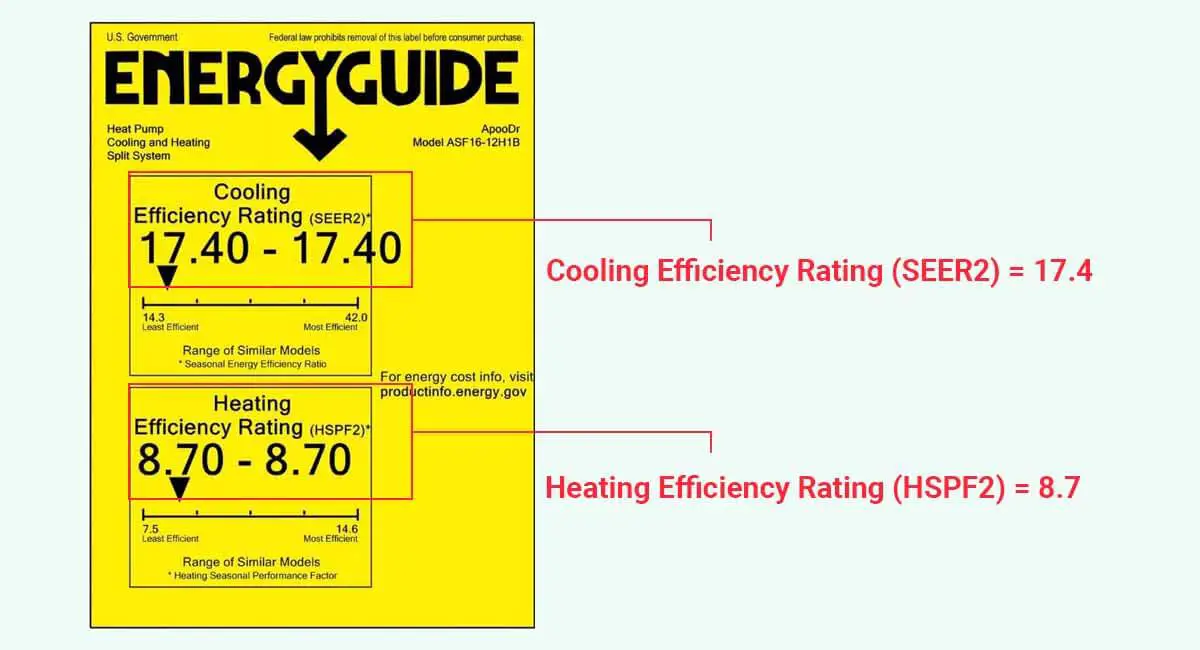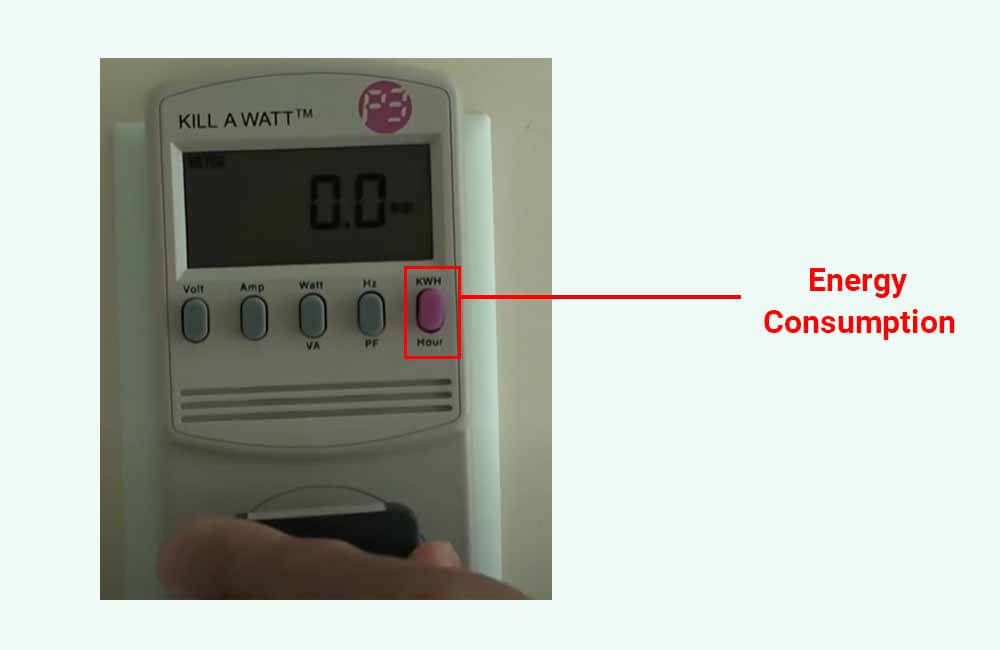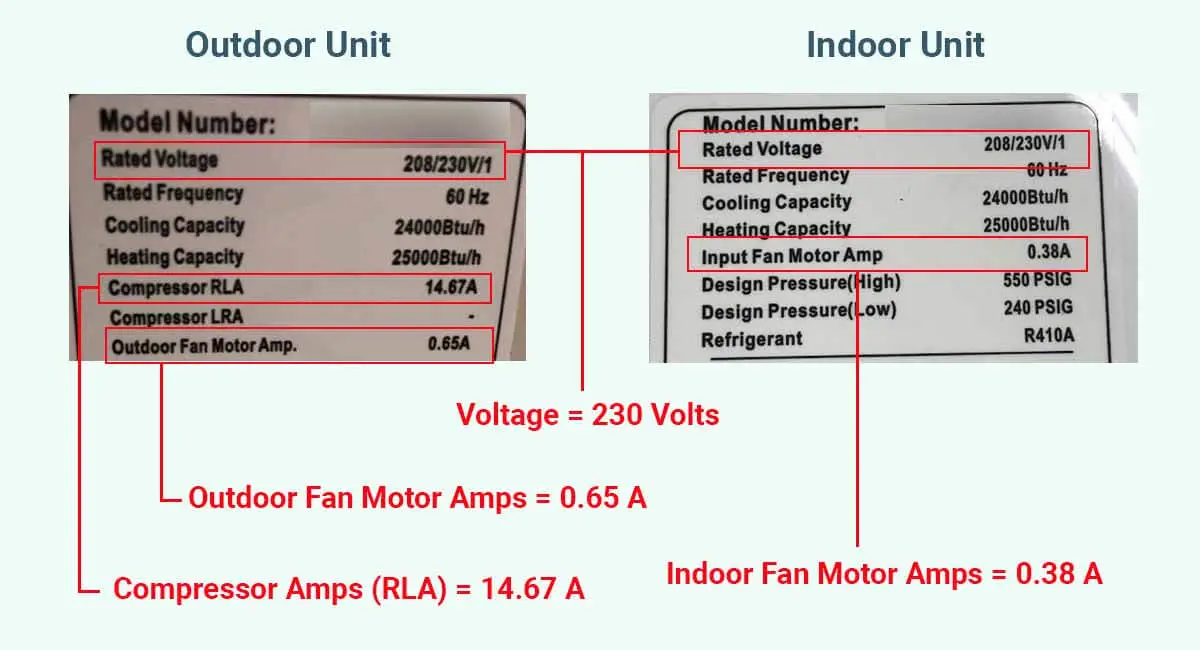Compared to other types of air conditioners, such as window AC units and ducted air conditioners, mini-splits are pretty energy-efficient, in the sense that they use less power (kW) and consume less energy (kWh) to perform the same amount of heat exchange.
But in general, the electricity consumption of air conditioners and heat pumps is still known to be relatively high. So, the question remains, How much electricity does a mini-split use? and how much does it cost to run a mini-split?
Well, in this article, I’ll discuss the energy consumption (kWh) of mini split air conditioners and heat pumps and how much it costs to run these units.
In case you’re planning on running your mini split on anything other than grid power, such as a generator, you’ll also want to learn about the power usage (wattage) of these units, which I’ll also discuss in this article.
Let’s dive in.
I get commissions for purchases made through links in this post.
Do mini-splits use a lot of electricity?
Air conditioners and heat pumps do indeed consume a relatively high amount of electricity when compared to other common household appliances like refrigerators, lights, TVs, and computers.
However, when we compare the electricity usage of ductless mini splits to other HVAC systems, such as ducted central ACs and heat pumps, window air conditioners, and portable air conditioners, ductless mini splits are more energy-efficient and do not use a lot of electricity.
This increased efficiency is primarily because mini splits deliver cooling and heating directly to the targeted space, as opposed to traditional central AC and heat pump systems that distribute air through a network of ducts, which leads to significant energy loss.
In fact, according to the U.S. Department of Energy (DOE), between 25% and 40% of heating or cooling energy is lost in ductwork, making ductless mini splits at least 25% more energy-efficient than ducted HVAC systems.
Furthermore, many mini split systems on the market feature compressors equipped with inverter technology. This technology allows the compressors to operate at variable speeds rather than simply being ON or OFF, as is the case with traditional compressors. This variable speed operation enhances their energy efficiency significantly.
To illustrate this, consider a study in which two identical rooms were equipped with air conditioners—one with an inverter mini-split and the other with a non-inverter mini-split.
Over 108 days, the study measured the energy consumption of each air conditioner. The results showed that the inverter air conditioner consumed, on average, 44% less energy than the non-inverter air conditioner.
How much electricity does a mini split use?
The energy usage of a mini-split, like other types of air conditioners and heat pumps, depends on factors such as its cooling/heating capacity, energy efficiency, and whether it’s in cooling or heating mode.
For example, during the cooling season, as a general guideline, a mini-split air conditioner or heat pump will typically consume between 0.45 and 0.8 kWh of energy per hour, for every ton (12,000 BTUs) of cooling it provides.
Conversely, in the heating season, a mini-split heat pump will typically consume between 1 and 1.5 kWh of energy per hour for every ton (12,000 BTUs) of heating it delivers.
To provide a practical example, a 9,000 BTU mini-split heat pump will usually consume between 0.35 and 0.6 kWh of energy per hour during the cooling season, and between 0.75 and 1.1 kWh per hour during the heating season.
Here’s a table to help visualize the estimated hourly energy usage of mini-splits based on their capacity (tons/BTUs) and whether they’re providing cooling or heating:
| BTU rating | Est. Hourly Energy Consumption (kWh/hour) — Cooling | Est. Hourly Energy Consumption (kWh/hour) — Heating |
| 9,000 BTUs | 0.35 – 0.6 kWh/hour | 0.75 – 1.1 kWh/hour |
| 12,000 BTUs (1 ton) | 0.45 – 0.8 kWh/hour | 1 – 1.5 kWh/hour |
| 15,000 BTUs | 0.6 – 1 kWh/hour | 1.25 – 1.85 kWh/hour |
| 18,000 BTUs (1.5 tons) | 0.7 – 1.2 kWh/hour | 1.5 – 2.2 kWh/hour |
| 24,000 BTUs (2 tons) | 0.95 – 1.6 kWh/hour | 2 – 3 kWh/hour |
| 36,000 BTUs (3 tons) | 1.5 – 2.4 kWh/hour | 3 – 4.5 kWh/hour |
| 48,000 BTUs (4 tons) | 1.9 – 3.2 kWh/hour | 4 – 6 kWh/hour |
| 60,000 BTUs (5 tons) | 2.4 – 4 kWh/hour | 5 – 7.5 kWh/hour |
These figures should provide an estimate of the typical hourly kWh usage of your mini-split. To determine daily or monthly energy consumption, you can combine this data with your daily usage in hours:
Daily Energy Consumption (kWh/day) = Hourly Energy Consumption (kWh/hour) x Daily Usage (hours/day)
Monthly Energy Consumption (kWh/month) = Daily Energy Consumption (kWh/day) x 30 (days/month)
However, if you’d like a more precise estimate of your mini-split’s hourly energy consumption, I recommend using its energy efficiency rating.
Let me elaborate.
The tonnage or BTU rating of your mini-split indicates the amount of heat it can either remove or add within an hour. The energy required to perform this heat exchange depends on the energy efficiency of the unit.
Energy Efficiency = BTUs delivered or removed ÷ Energy Consumed
The higher the energy efficiency of the unit, the less energy it will require to perform the same amount of heat exchange.
Manufacturers typically conduct tests to determine the energy efficiency of mini-splits and provide energy efficiency ratings, including:
- SEER (Seasonal Energy Efficiency Ratio): This rating represents the energy efficiency of cooling-only mini-splits or the cooling efficiency for mini-split heat pumps that provide both cooling and heating.
- HSPF (Heating Seasonal Performance Factor): This rating represents the heating efficiency of a mini-split heat pump.
To estimate the hourly energy consumption of your cooling-only mini-split or the energy consumption of your mini-split heat pump during the cooling season, you can use the following formula:
Hourly Energy Consumption (kWh/hour) = (BTU rating ÷ SEER) ÷ 1000
To estimate the hourly energy consumption of your mini-split heat pump during the heating season, you can use this formula:
Hourly Energy Consumption (kWh/hour) = (BTU rating ÷ HSPF) ÷ 1000
For example, consider the following mini-split heat pump rated at 12,000 BTUs:

The hourly energy usage of this mini-split unit during the cooling season can be calculated as follows:
Hourly Energy Consumption (kWh/hour) = (BTU rating ÷ SEER) ÷ 1000
Hourly Energy Consumption (kWh/hour) = (12,000 ÷ 17.4) ÷ 1000
Hourly Energy Consumption (kWh/hour) = 12 ÷ 17.4
Hourly Energy Consumption (kWh/hour) = 0.69 kWh/hour
And its hourly energy usage during the heating season can be calculated as follows:
Hourly Energy Consumption (kWh/hour) = (BTU rating ÷ HSPF) ÷ 1000
Hourly Energy Consumption (kWh/hour) = (12,000 ÷ 8.7) ÷ 1000
Hourly Energy Consumption (kWh/hour) = 12 ÷ 8.7
Hourly Energy Consumption (kWh/hour) = 1.37 kWh/hour
As mentioned earlier, these hourly energy usage figures can be used to estimate the daily and monthly energy consumption of the mini-split, which can then be combined with the electricity costs in your area to determine the cost of operating the unit.
However, it’s essential to note that the exact energy consumption of a mini-split is influenced by factors beyond its cooling/heating capacity, energy efficiency, and mode of operation.
Factors such as outdoor temperature, indoor temperature settings, the quality of insulation, and the condition of the unit also play significant roles in energy consumption.
Because of these variables, accurately predicting the energy usage of mini-splits can be challenging.
A much more accurate method to determine the energy consumption of your mini split is to measure it.
How to measure a mini-split’s energy consumption accurately?
The most accurate way to determine the energy consumption of your mini-split, or any appliance for that matter, is by using an electricity monitoring device such as the Kill-A-Watt meter or a similar device.
These devices provide readings of electricity usage, including Amps, Volts, and Watts, and are particularly valuable for measuring the energy consumption of an appliance over a specific timeframe.
To measure the energy consumption of your mini-split AC unit using the Kill-A-Watt meter, follow these steps:
- Plug the monitoring device into an electrical outlet.
- Plug your mini-split unit into the monitoring device.
- Allow the mini-split unit to run for the desired period that you want to measure.
- Press the purple button labeled “kWh” on the Kill-A-Watt meter to determine the energy consumption of the mini-split over the specified time frame.
By using this method, you can obtain precise data on the energy consumption of your mini-split under actual operating conditions, which can help manage energy usage and costs effectively.

Here’s a video that explains how to use a Kill-A-Watt meter:
Now that we’ve explored the energy consumption of these units and the methods for estimating or measuring it, let’s delve into the actual operating costs associated with running a mini-split.
How much does it cost to run a mini-split?
Based on the latest data from the U.S. Energy Information Administration (EIA) in June 2023, the average cost per kWh in the United States stands at approximately 16 cents ($0.16).
For instance, if your mini-split air conditioner consumes 150 kWh of energy per month, the average monthly cost to operate the AC unit would be approximately $24.
To offer a preliminary reference, here’s a table estimating the hourly operating costs of mini-splits based on their cooling and heating capacity during both the cooling and heating seasons:
| BTU Rating | Est. Hourly Cost for Cooling | Est. Hourly Cost for Heating |
| 9,000 BTUs | 8 cents/hour ($0.08/hour) | 14 cents/hour ($0.14/hour) |
| 12,000 BTUs (1 ton) | 10 cents/hour ($0.1/hour) | 20 cents/hour ($0.2/hour) |
| 15,000 BTUs | 13 cents/hour ($0.13/hour) | 25 cents/hour ($0.25/hour) |
| 18,000 BTUs (1.5 tons) | 16 cents/hour ($0.16/hour) | 30 cents/hour ($0.3/hour) |
| 24,000 BTUs (2 tons) | 20 cents/hour ($0.2/hour) | 40 cents/hour ($0.4/hour) |
| 36,000 BTUs (3 tons) | 30 cents/hour ($0.3/hour) | 60 cents/hour ($0.6/hour) |
| 48,000 BTUs (4 tons) | 40 cents/hour ($0.4/hour) | 80 cents/hour ($0.8/hour) |
| 60,000 BTUs (5 tons) | 50 cents/hour ($0.5/hour) | 100 cents/hour ($1/hour) |
Please note that the costs provided in the table were calculated using the average hourly energy consumption of these mini-splits, coupled with the U.S. national average cost per kWh in June 2023.
The actual cost of operating your mini-split AC unit depends on two primary factors:
- Energy Consumption of the AC: This is measured in kWh (kiloWatt-hours) and can be estimated using the methods explained earlier or by utilizing an electricity monitoring device.
- Cost per kWh in Your Region: You can find this information on your utility bill or by referring to estimates provided by the Energy Information Administration (EIA).
To calculate the cost, you can use the following formula:
Cost = Energy Consumption of the AC (kWh) x Cost per kWh ($/kWh)
For instance, let’s consider the following scenario:
You are using a 12,000 BTU mini-split heat pump that, on average, consumes approximately 120 kWh of energy each month during the cooling season, and around 200 kWh per month during the heating season.
Let’s also assume that you’re located in Nevada, where, as per the EIA, the cost of 1 kWh of electricity is approximately 17 cents ($0.17/kWh).
The average monthly cost to operate your mini-split unit would be as follows:
Cooling Season:
Cost = Energy Consumption (kWh) x Cost per kWh ($/kWh)
Cost = 120 kWh x $0.17/kWh
Cost = $20.4
Heating Season:
Cost = Energy Consumption (kWh) x Cost per kWh ($/kWh)
Cost = 200 kWh x $0.17/kWh
Cost = $34
To simplify the process and provide you with a more precise cost estimate, I’ve created a calculator that calculates the operating expenses of your mini-split based on the following:
- The unit’s capacity (BTU rating).
- Whether it’s used for cooling or heating.
- Your typical daily usage of the unit (in hours).
- Your location (State) and the cost per kWh in your area.
Now that we’ve covered the energy consumption (kWh) of mini-split air conditioners and the associated costs, let’s move on to explore the power usage (kW) of these units.
The insights provided in the next section will prove valuable, especially if you’re considering operating your mini-split AC unit using alternative energy sources.
Mini split AC Power Usage: How many watts does a mini split use?
The power usage (in watts) of a mini-split air conditioner or heat pump, often referred to as wattage, is primarily determined by its capacity, measured in BTU rating or tonnage. For instance, a 12,000 BTU mini-split typically has a rated wattage of around 1600 watts, while a 24,000 BTU unit usually operates at about 3200 watts.
However, it’s essential to note that mini-splits with the same BTU rating may have varying power ratings based on factors such as refrigerant type, unit design, and efficiency.
Here’s a table outlining the rated wattage range for mini-split ACs and heat pumps based on their cooling/heating capacity (BTUs/Tons):
| Capacity | Rated Wattage Range |
| 9,000 BTUs | 1,100 – 1,500 Watts |
| 12,000 BTUs (1 ton) | 1,400 – 2,000 Watts |
| 15,000 BTUs | 1,750 – 2,500 Watts |
| 18,000 BTUs (1.5 tons) | 2,100 – 3,000 Watts |
| 24,000 BTUs (2 tons) | 2,800 – 4,000 Watts |
| 36,000 BTUs (3 tons) | 4,200 – 6,000 Watt |
| 48,000 BTUs (4 tons) | 5,600 – 8,000 Watts |
| 60,000 BTUs (5 tons) | 7,000 – 10,000 Watts |
The rated Wattage of your mini-split will likely fall somewhere in these ranges. However, to accurately determine the power rating (wattage) of your mini-split, you should rely on the electrical specifications provided by the manufacturer.
These specifications include:
- Voltage (in Volts): The electrical potential difference that drives the current in the system, typically measured in Volts (V).
- Compressor Amperage/RLA (in Amps): The maximum current (amperage) that the compressor will draw during its normal operation. This is often referred to as the Rated Load Amps (RLA).
- Outdoor (Condenser) Fan Motor Amperage/FLA (in Amps): The amperage the outdoor fan motor draws under full load, usually specified as Full Load Amps (FLA).
- Indoor (Evaporator) Fan Motor Amperage/FLA (in Amps): The amperage the indoor fan motor draws under full load, also specified as Full Load Amps (FLA).
With these specifications, you can calculate the rated wattage (power) of your mini-split using the formula:
Rated Wattage (Watts) = Rated Current (Amps) x Voltage (Volts)
where
Rated Current (Amps) = Compressor Amperage (Amps) + Outdoor Fan Motor Amperage (Amps) + Indoor Fan Motor Amperage (Amps)
The voltage, compressor RLA, and outdoor fan motor FLA are usually specified on the outdoor unit’s nameplate, while the indoor fan motor FLA might be indicated on either the condenser or indoor unit.
As an example, let’s take a look at these nameplates on the outdoor and indoor units of a 24,000 BTU mini-split heat pump:

First, let’s calculate the rated Amperage of the unit:
Rated Current (Amps) = Compressor Amperage (Amps) + Outdoor Fan Motor Amperage (Amps) + Indoor Fan Motor Amperage (Amps)
Rated Current (Amps) = 14.67 Amps + 0.65 Amps + 0.38 Amps
Rated Current (Amps) = 15.7 Amps
The rated Wattage of this mini-split heat pump can then be calculated as follows:
Rated Wattage (Watts) = Rated Current (Amps) x Voltage (Volts)
Rated Wattage (Watts) = 15.7 Amps x 230 Volts
Rated Wattage (Watts) = 3611 Watts
Now, it’s important to note that, most modern mini-split air conditioners and heat pumps are equipped with inverter-driven compressors, allowing them to adjust their output based on cooling/heating needs.
Therefore, they don’t operate at a fixed wattage. The rated wattage represents the maximum power usage, although the actual usage may be lower.
When sizing equipment like an inverter or a generator for your mini-split, it’s essential to ensure their wattage capacity exceeds the maximum power (Watts) the unit may require. In the case of inverter mini-splits, this is their rated wattage.
For non-inverter mini-splits, manufacturers provide an additional Amperage rating, the Compressor Locked Rotor Amps (LRA), representing the current (Amps) the unit’s compressor may need during start-up.
This rating, along with other electrical specifications, can be used to calculate the starting wattage of the unit:
- Starting Wattage (Watts) = Starting Current (Amps) x Voltage (Volts)
- Starting Current (Amps) = Compressor LRA (Amps) + Outdoor Fan Motor Amperage (Amps) + Indoor Fan Motor Amperage (Amps)
Ensuring the equipment can handle the starting wattage guarantees it can reliably power your mini-split without overloading or causing issues.










Hello Younes!
Fabulous article, and the ONLY place on the entire web where I could find good answers to electrical power consumption questions!! MANY THANKS! I am trying to work out how to size a portable electrical generator for backup and needed to know the wattage.
Appreciate your wisdom!
Hey there Bill,
I appreciate it.
I would say a 2000 Watt generator will do the trick for anything less than 18000 BTUs, maybe even up to 24000 BTUs, since mini splits with this kind of capacity will generally use less than 2000 Watts of power and don’t require a huge amount of power when starting up.
Before you make any purchases, please refer to the specification label of your unit, and look for the amperage rating specified (in Amps or “A” for short) by the manufacturer.
Once you find this amperage rating, multiply it by the voltage rating of the unit (around 120 Volts). This will help you determine the power usage of your unit more accurately.
For example, if your unit is rated at 115 Volts and 12 Amps, its rated power usage will be 115 V x 12 A = 1380 Watts. A 2000W generator will do the trick.
Hope this helps.